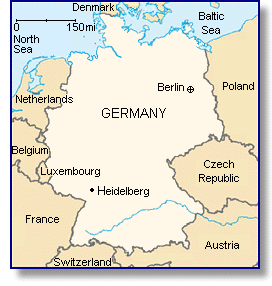 Destination Ludwigshafen, Germany:
Destination Ludwigshafen, Germany:
Bright Times for Buna
< Back | Main menu | PSLC | Next >
German rubber companies are still grumbling about the new Buna-S rubber in the late 1930's. It really is more trouble than it's worth, and the government keeps making them use more and more of it. The American companies sit back and watch, snickering quietly to themselves, as the German companies struggle to make it work. It is getting to where the word Buna is a four letter word, if you know what I mean. The world will change it's tune soon enough.
In 1934, Eduard Tschunkur and Erich Konrad decide to exchange the styrene of Buna-S rubber with a more expensive chemical, acrylonitrile. This simple experiment results in a new product: Buna-N or Perbunan. This new rubber has really great properties, like Buna-S, but with the added bonus of oil resistance. Now the rubber companies do not complain so much. Even though it is only a specialty rubber, it is worth the effort to process. It also makes the German government happy, because there is no need to import the American oil resistant rubbers, Thiokol and neoprene, now that they have their own.
Buna comes to America
Buna-N is introduced to the United States by accident in 1937. No, a sample was not shipped to New York when it was destined for Madagascar. The DuPont neoprene plant is out of commission for a long time due to an enormous explosion, so no one can buy any neoprene. The rubber trade has become accustomed to using the oil resistant rubber, but there is none to be had. Some companies can use Thiokol instead, but most cannot. In a desperate attempt to not lose any customers, DuPont asks I.G. Farben for some samples of it's new Buna-N rubber. After testing, DuPont finds the rubber to be satisfactory and orders enough to supply it's customers. Slowly, American use of German Buna-N rubber increases, even though it costs almost 10 times as much as natural rubber at the time and 30 to 50 cents more than neoprene. Once the American rubber companies see how good Buna-N is, they start requesting samples of Buna-S, and the German companies realize that their product isn't so bad after all.
-
Next stop: New Jersey - Airliners
Meanwhile...
The synthesis of Buna-N rubber is not the only interesting event of 1934. Here are a few others:Tritium, the third isotope of hydrogen, is discovered.
The world's first main-line train powered by a diesel-electric locomotive, The Burlington Zephyr, begins regular passenger service.
The notorious criminal, John Dillinger, is captured, imprisoned, then escapes and is later shot when leaving a movie theater in Chicago.
References
-
1. Herbert, Vernon and Attilio Bisio. Synthetic Rubber: A Project That Had to Succeed. Westport, Connecticut: Greenwood Press, 1985.
2. Howard, Frank A. Buna Rubber: The Birth of an Industry, D. van Nostrand Company, Inc., 1947.
3. Wolf, Howard and Ralph. Rubber: A Story of Glory and Greed. New York: Covici, Friede, 1936.
and the Chemical Heritage Foundation
